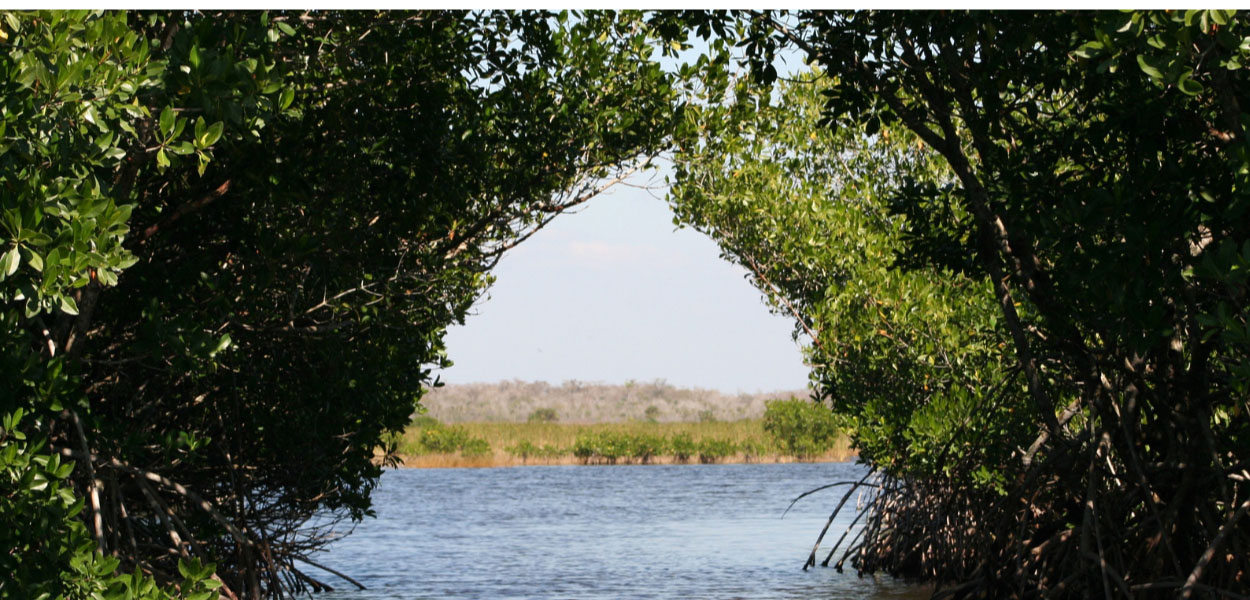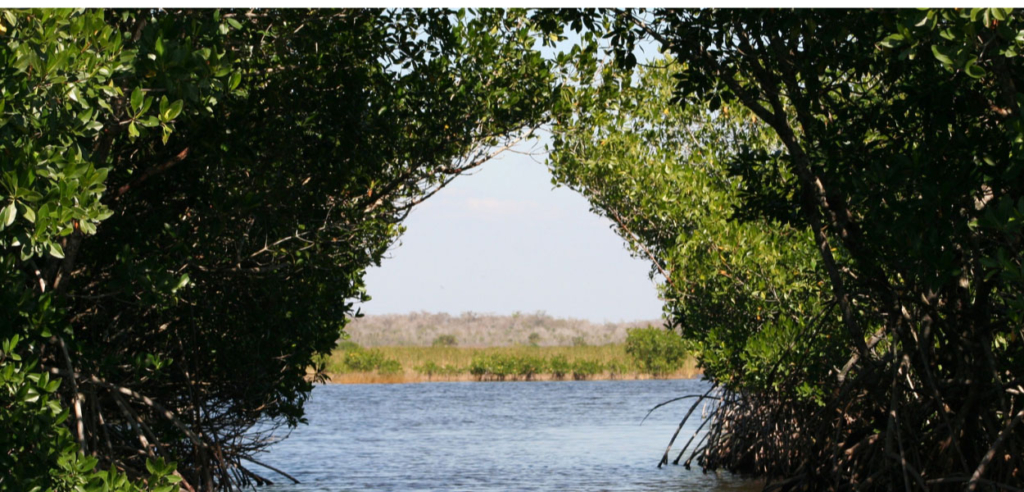Today, 26th of July, is the International Day for the Conservation of the Mangrove Ecosystem. Mangrove forests have been under threat of disappearing for a while now. The event thus aims to put forth the importance of mangroves in upkeeping the environment’s wellbeing.

It is an effort to save them from decline by educating people on the subject. We are here to answer all of your questions. What exactly are mangroves? Why are they so important? And who is endangering them? We provide the ultimate guide to the mangrove ecosystem.
What’s The Mangrove Ecosystem
The term “mangrove” can refer to two things. First, it can refer to a type of woody tree that grows along coastlines. Mangroves do not belong to a single species but rather to a number of them, all sharing certain characteristics. Their exposed breathing roots and mechanisms to either block out or discharge salt allow them to grow in salty, oxygen-poor environments. Still, different species have different shapes and sizes.
Second, the word “mangrove” can refer to an ecosystem that mangrove trees make up of and inhabit. Mangrove ecosystems are true hubs of diversity. They associate with other ecosystems including sand flats, mudflats, algal beds, seagrass beds, and coral reefs. Such associations result in the flourishing of a number of species of birds, mammals, reptiles, and fish. For example, Australia’s mangroves house over 200 bird species. Furthermore, more than 600 species of fish frequent those of the Indo-Pacific area.
In this sense, mangroves exist in two specific regions of the world. They extend from East Africa to Polynesia in the Indo-West Pacific region. In the Atlantic East Pacific area, they populate the Americas and West and Central Africa.
Yet it is not all sunshine and rainbows. Mangroves have been in decline for a long time. About half of the surface such ecosystems took up in 1980 is now gone, and it’s all because of us.
Why The Mangrove Ecosystem Is Under Threat
There are many, many reasons why mangroves are disappearing. Unsurprisingly, they are all related to human activity.
Shrimp Farming
The number one reason why mangroves are in decline is the rising prosperity of shrimp farming. Approximately 35% of all mangroves have been destroyed to make room for shrimp farms. All because of the increasing demand for shrimp that currently plagues the United States, Europe, China, and Japan.
Climate Change
Located in-between land and sea, mangroves are extremely sensitive to the rising sea level. Hence, if temperatures continue to rise, entire forests could disappear beneath the ocean.
Coastal Development
A growing population translates into a need for more land to inhabit. Flat coastal areas are particularly adept for human activities. Mangroves are thus wiped off in the name of development and urbanization.
Conversion to Agriculture
A growing population also means a need for more land to grow food. It is hence common practice to totally clear out mangroves in order to develop new aquacultural and agricultural sites. Evidently, this is a major contributing factor in the disappearance of mangrove ecosystems.
It is thus clear why mangroves are under threat of completely disappearing. But why would the decline of mangrove forests represent such a great threat to the environment as a whole?
The Consequences of The Decline of Mangrove Ecosystems
The astounding diversity of mangroves means that their disappearance would entail a great, general loss of diversity. This is instinctually undesirable. Nevertheless, the consequences of such decline could be far greater than just that.
The Loss of Ecosystem Services
Locals can be highly dependent on mangrove ecosystem services. Some rely on fishing for self-consumption or commercialization. It’s also common for them to use mangrove trees to produce furniture, fish traps, medicine, honey, and palm thatch. Additionally, mangrove forests are often linked to the local community’s history and religious beliefs.
It is thus easy to see how detrimental the destruction of mangroves can be for the wellbeing of local communities. Such a thing means the loss of their cultural identities, as well as pervasive poverty and bad health. Considering that most mangrove forests are located in developing countries, said effects are far worse than one could ever imagine.
The Loss of Protection From Natural Disasters
Astonishingly, mangroves have the capacity to protect local populations and ecosystems from natural disasters. They can reduce the impact of cyclones and tsunamis by decreasing the actions of waves and the effects of flooding. They can additionally retain sediment and diminish coastal erosion by keeping the soil together with their roots.

The destruction of mangroves is thus rendering local communities even more vulnerable, further exposing them to natural disasters.
The Loss of Climate Regulation
Though mangroves represent less than 2% of marine ecosystems, they remarkably account for about 15% of carbon burial. Indeed, mangrove trees extract carbon dioxide from the air and use it to build their leaves, roots, and branches. Once dead, said parts collapse to the seafloor, burying themselves into the soil and bringing the carbon with them.
This is clearly an efficient tool against climate change. Instead of appreciating that, however, we humans have seemingly decided to counteract it. First, wiping out mangrove forests definitely prevents them from carrying out the mentioned process. Second, such destruction automatically releases the accumulated carbon back into the air. This is obviously extremely detrimental to the fight against global warming. In fact, carbon emissions resulting from said phenomenon represent about one-fifth of all emissions from deforestation.
The Loss of Water Quality Maintenance
Due to the special composition of mangrove trees and the structure of their roots, mangroves can filter ocean waters. Consequently, they have the capacity to render water safe for human populations and surrounding ecosystems.
Hence, the disappearance of mangroves allows for water quality to decline. This puts human populations at risk and even causes nearby ecosystems to collapse.

Impoverished populations, exacerbated climate change and diversity losses paint a rather grim picture of what the future might look like. If we continue to put comfort over sustainability—destroying mangrove ecosystems—we might get to a point of no return. Thankfully, however, we are not there yet. We can still save the mangroves. And more than a few people are working on it.
Efforts to Protect the Mangroves
The Flaws of the Prevailing Method of Restoration
The prevailing method of mangrove restoration is precisely what you might expect. The technique is based on planting mangrove trees where old ecosystems used to be. NGOs that implement this method usually opt for the easiest species to plant. Nevertheless, mangrove trees are not one-size-fits-all. Different species flourish in specific environments. Failure to recognize this has also proven to mean failure to restore.
Community-based ecological mangrove restoration (CBEMR)
Contrary to the more traditional approach, CBEMR looks at specific environmental conditions. It focuses on choosing the right mangrove species and planting only a few specimens. The idea is to let the trees take hold; to let nature take its course. The said technique has proven to be faster and more successful in the long run.
The CBEMR technique also concentrates on the value of local communities. It aims to educate them on the ins and outs of mangroves. It is all in an effort to equip local populations with the necessary tools to both protect and benefit from the forests.
Groups
More and more groups with the intention to restore and conserve mangroves have emerged. Some focus on protecting forests that are in danger of deforestation. Others focus on the importance of local communities. The Mangrove Alliance, for instance, created an app that allows locals to inform and get information regarding the health of mangroves.
These solutions thankfully provide hope for the future and assurance that there are still people out there who care. Still, said efforts might seem a little impersonal. They don’t allow for the impression of powerlessness to disappear. What can one do if one doesn’t live next to a mangrove? There are some individual actions that could make a difference.
What You Can Do to Help
The reality is that nothing holds more power than money. Thus, where you spend your money matters. Brands respond to what the consumer wants. They provide it, as long as the consumer makes their wants clear through their purchasing choices.
Under such logic, if you want to help the restoration of the mangrove ecosystems, you must promote it through your purchasing choices. The most obvious thing would be to look for sustainable alternatives to eating farmed shrimp. This would encourage shrimp producers to opt for sustainable methods, for that’s what the consumer wants. You could also buy from brands that support the restoration of mangroves, such as MANG. The clothing brand plants a mangrove for each product it sells.
Other than that, the options are limited. But what is important is that you make the effort to educate yourself. You can only fight for a cause if you know what the cause is and how the fight can be undertaken. And now you know the basics. You are on the right track to help save the mangroves.
Did you like this article? Check out what earth overshoot day is!






